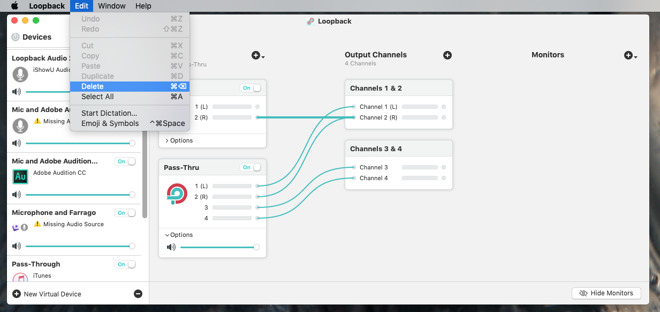Mac Audio Routing App
The Mac packs some powerful built-in audio options, but they only let you route audio out through hardware devices — the built-in speakers, connected headphones, AirPlay speakers,. Cable-free audio routing for Mac. With the power of Loopback, it's easy to pass audio from one application to. Soundflower is a virtual audio device for OS X that can pass audio from applications to other applications. It does this by routing your audio output as an audio input to the system. After installation, a new device will be available in System Preferences Sound. Go to the Input tab and select Soundflower (2ch) as the input device. Step 1: Install Audio Hijack Pro. You can find it from Rogue Amoeba’s website and it comes with a free trial. Step 2: Launch Audio Hijack Pro and add a new source using the ‘+’ button in the bottom left-hand corner of the app.
I couldn’t podcast without the software made by Rogue Amoeba. Their suite of Mac apps including Audio Hijack, Farrago, and Loopback allow me to put together a live podcast production that can rival anything created in a professional studio.
That last piece of software, Loopback, lets you take sound from any app and route it to other devices. For example, I can take audio from YouTube and send it to a caller on Skype. Or I can take music I’m playing in Spotify and send it to my co-hosts. Or I can take me, my co-hosts, a caller, sound effects, and music, and feed it all into a live stream — all while making sure my co-hosts and caller can hear everything I’m hearing.
Truly, Loopback is a dream come true for podcasters who want to create a show with live elements like music, callers, and sound effects. Before Loopback, someone looking to do these things would have to have a physical mixer and numerous physical audio sources. Loopback puts an entire studio into a single computer, and that is freakin’ amazing.
As you can tell, Loopback has been a favorite of mine since it launched. But in late November Loopback got even better with Loopback 2.
The new version has lots of new features, but there are two in particular that Loopback users new and old will be thrilled about: There’s an overhauled UI that makes it easier to set up your “studio,” and even better, each app now has its own volume controls, giving you incredible control over your mix.
Mac Audio Routing Software
The screenshot below shows a simple setup. Each “Device” in the left column is a virtual device that holds a collection of apps. In the right column, you select every app you want to be heard in the virtual device. Once you have your virtual device setup, you set it as an input in whatever app you want this collection of sounds to be heading to.
Map Routing App
Full Loopback 2 details can be found here.
As I said, I use some of the other apps as well. I use their new-ish app Farrago to play and store sound effects / music intros, and I use Audio Hijack for the actual recording of my shows.
Audio Hijack has been available for well over a decade but received a major makeover in 2015. This is very powerful recording software that lets you record any app you’d like (simultaneously if you want), but it doesn’t stop there. Audio Hijack will also let you split the input and output into separate audio tracks (great for recording Skype calls), add effects to audio sources, and it’ll save your recordings automatically — even if you encounter a power outage (GOD SEND).
Best Audio Routing App For Mac

I highly, highly recommend Rogue Amoeba’s apps for any Mac podcaster. If you’re interested in buying them, be sure to check out their Podcast Bundle offer. This’ll give you a $50 discount on the purchase of the three aforementioned apps plus their audio editing app Fission. There’s also an Audio Hijack + Loopback bundle which’ll take off $30.

If you need help setting these up, I’m here. Check out my Podcast Consultations page for more.
Sound Control 2.5.0 is a FREE upgrade for all owners of Sound Control.
Version 2.5.0
- Devices menu now shows the Master Volume.
- Input devices now properly show and update the muted state.
- Toggle mute for default input device now shows the HUD to indicate status change.
- Add hotkeys for controlling the default input device’s gain and mute.
- Input devices now show gain dB value properly.
- Changing the gain of an input device no longer beeps.
- Added Priority devices for Input devices.
- Added HotKeys for changing the default input device.
- Volume feedback beeps now play on the appropriate device.
- Sound Control no longer interferes with macOS automatic device selection if priority devices are not enabled.
- Reduced CPU use.
- Added option to show and control apps that have been explicitly added to the listing.
- Fixed audio distortion after switching sample rates on bluetooth devices.
- Addressed application hang when switching to a bluetooth device or a built-in device on T2 Macs.
- Master volume displayed in the touch bar now updates properly when the default output device is changed.
- Added support for AirPlay!
- Added AppleScript support for setting mute, volume and balance.
- Added support for Zoom Thunderbolt audio devices.
- Sound Control volume change overlay more closely matches the system.
- Fixed a crash that could happen when muting AirPods Pro.
- Menu bar icon no longer shows disabled if STZ Audio Process plugin isn’t installed.
- Last version to support macOS 10.11 (El Capitan), 10.12 (Sierra), 10.13 (High Sierra. The next update to Sound Control will require macOS 10.14 (Mojave).